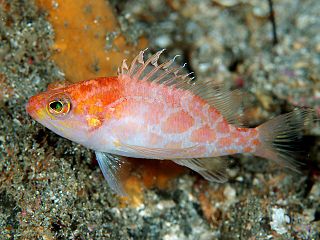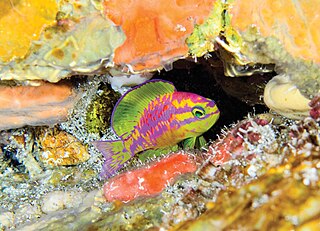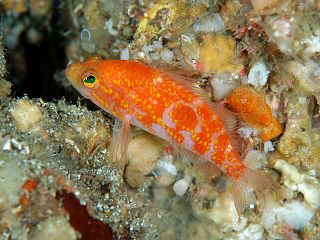
The Rapa Nui are the indigenous Polynesian peoples of Easter Island. The easternmost Polynesian culture, the descendants of the original people of Easter Island make up about 60% of the current Easter Island population and have a significant portion of their population residing in mainland Chile. They speak both the traditional Rapa Nui language and the primary language of Chile, Spanish. At the 2017 census there were 7,750 island inhabitants—almost all living in the village of Hanga Roa on the sheltered west coast.

Anthias are members of the family Anthiadidae in the order Perciformes. The group has also been called Anthiidae or Anthiinae, but these names are preoccupied by a subfamily of ground beetles in the family Carabidae erected by Bonelli in 1813.
Pierre Fourmanoir (1924–2007) was a French ichthyologist working mainly in New Caledonia. He described many new species of fish including several sharks.

Plectranthias is a genus of ray-finned fish in the subfamily Anthiinae, part of the family Serranidae, the groupers and sea basses. They are found in the Atlantic, Indian and Pacific Ocean.

Luzonichthys is a genus of marine ray-finned fish in the family Anthiadidae.

A mesophotic coral reef or mesophotic coral ecosystem (MCE), originally from the Latin word meso (meaning middle) and photic (meaning light), is characterized by the presence of both light-dependent coral and algae, and organisms that can be found in water with low light penetration. Mesophotic coral ecosystems occur at depths beyond those typically associated with coral reefs as the mesophotic ranges from brightly lit to some areas where light does not reach. Mesophotic coral ecosystem (MCEs) is a new, widely adopted term used to refer to mesophotic coral reefs, as opposed to other similar terms like "deep coral reef communities" and "twilight zone", since those terms sometimes are confused due to their unclear, interchangeable nature. Many species of fish and corals are endemic to the MCEs making these ecosystems a crucial component in maintaining global diversity. Recently, there has been increased focus on the MCEs as these reefs are a crucial part of the coral reef systems serving as a potential refuge area for shallow coral reef taxa such as coral and sponges. Advances in recent technologies such as remotely operated underwater vehicles (ROVs) and autonomous underwater vehicles (AUVs) have enabled humans to conduct further research on these ecosystems and monitor these marine environments.

Tosanoides aphrodite, the Aphrodite anthias, is a species of marine ray-finned fish, from the family Anthiadidae. It was discovered in the Atlantic Ocean in 2018, the only one in its genus to be discovered there. It was first identified by Luiz A. Rocha and Hudson Pinheiro, staff members of the California Academy of Sciences. The fish is electric pink and yellow and has bright green fins. It was discovered on a remote Brazilian archipelago in the Atlantic Ocean and can be distinguished by 15-16 soft dorsal fin rays and 9 anal fin rays. They are sexually dichromatic, meaning the males and females are different colors. It is named after Aphrodite, the Greek goddess of love and beauty.
Plectranthias cruentus, the bloody perchlet, is a species of ray-finned fish in the subfamily Anthiinae, part of the family Serranidae, the groupers and sea basses.

Plectranthias takasei, the Hinomaru perchlet, is a species of fish in the family Serranidae.
Plectranthias wheeleri, the spotted perchlet, is a species of fish in the family Serranidae occurring in the western Pacific Ocean.
Plectranthias fourmanoiri, the doublespot perchlet, is a species of fish in the family Serranidae occurring in the Indo-Pacific Ocean.

Plectranthias inermis, the chequered perchlet, is a species of fish in the family Serranidae occurring in the Indo-West Pacific.
Plectranthias lasti, the trawl perchlet, is a species of fish in the family Serranidae occurring in the western Pacific Ocean.
Plectranthias robertsi, the filamentous perchlet, is a species of fish in the family Serranidae occurring in the western Pacific Ocean.
Plectranthias randalli, the emperor perchlet, is a species of fish in the family Serranidae occurring in the western Pacific Ocean.

Plectranthias bennetti, or Bennett's perchlet, is a species of fish in the family Serranidae occurring in the western Pacific Ocean.

Plectranthias hinano, or Hinano's perchlet, is a species of fish in the family Serranidae occurring in the north-western Pacific Ocean.

Plectranthias longimanus, the longfin perchlet, is a species of fish in the family Serranidae occurring in the Indo-Pacific Ocean.

Plectranthias polygonius, the polygon perchlet, is a species of fish in the family Serranidae occurring in the Pacific Ocean.
Plectranthias purpuralepis, the purple-scaled perchlet, is a species of fish in the family Serranidae occurring in the north-western Pacific Ocean.












